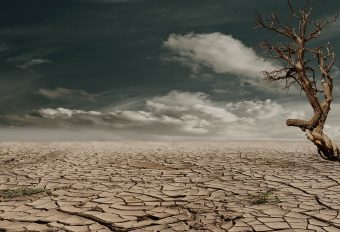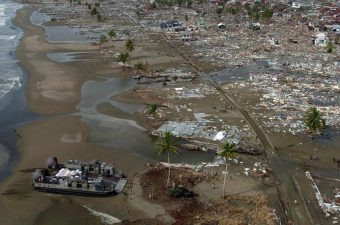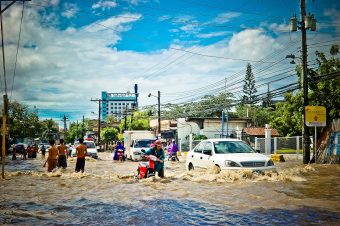
2020 State of Climate Services Report says 11,000 disasters caused by weather, climate and water-related hazards in the past 50 years.
As extreme weather and climate events have increased in frequency, intensity and severity, particularly due to climate change, the UN Food and Agriculture Organization (FAO) and its partners have warned that early warning systems, followed by early action, are critical to prevent disasters and save lives.
The Director-General of FAO, QU Dongyu, today participated in the launch of the 2020 State of Climate Services Report at a virtual high-level event hosted by the World Meteorological Organization (WMO), which produced the report with inputs from FAO and 15 other international agencies and financial institutions through the Global Framework for Climate Services. The report was released on the International Day for Disaster Risk Reduction.
“Pre-emptive action underpinned by effective weather data, early warning systems and disaster risk assessments can save millions of livelihoods in times of conflict and natural disaster,” Qu said.
More:
The Director-General stressed that many countries lack early warning systems and capacities. He also noted the COVID-19 pandemic had increased the vulnerabilities of the most-at-risk communities – such as farmers, pastoralists, fishers and foresters – to climate shocks and natural hazards.
“Early warning, Early action is therefore a key guiding principle for my administration in FAO to deal with potential risks for the global agri-food system, even before the latest outbreak of locust and the COVID-19 Pandemic,” said Qu, who alluded to his experience as former Vice Governor and leading coordinator responsible for agricultural, meteorological and disaster-prevention affairs in Ningxia Province of China. “I fully understand the importance of early warning systems to the agricultural sector and rural livelihoods,” he added.
FAO in action
The Director-General explained how early warning systems, big data and digital technology have been driving FAO’s work and commitment to get ahead of disasters and build better lives and livelihoods, emphasizing that the UN agency was looking forward to scale up its anticipatory action in the future.
The Hand-in-Hand Initiative already employs sector specific climate indicators like water productivity, precipitation anomalies, agriculture stress and advanced crop calendars, many of them developed jointly by FAO, WMO and global experts. It also incorporates, through the Geospatial Platform, over 1 million geospatial layers, thousands of statistics series with 4,000 metadata records at the global and regional level covering (amongst many others) climate, soil, land and water information.

The FAO Digital Services Portfolio informs Crop Calendars for more than 130 crops located in 283 agro-ecological zones in 44 countries; and the FAO Data Lab has been providing recommendations on planting and harvesting during the COVID-19 outbreak.
Furthermore, FAO’s Global Information and Early Warning System (GIEWS), established after the food crises of the early 1970s, continuously monitors food supply and demand and other key indicators for assessing the overall food security situation in all countries of the world. It issues regular analytical and objective reports on prevailing conditions and provides early warnings of impending food crises at country or regional level.
During the meeting, Qu cited the example of Bangladesh to show how joint efforts can anticipate the impact of floods. In July this year, the fastest allocation in history by the UN Central Emergency Response Fund significantly mitigated the damage.
The Director-General also highlighted the results achieved by FAO’s Desert Locust Information Service which has provided early warning against the ongoing locust outbreak in East Africa. FAO’s research, which provides one of 16 case studies in the 2020 report, triggered control and surveillance operations that spared 350,000 pastoral households from livelihood loss and distress, he said.
Main findings of the Report
The 2020 State of Climate Services Report, presented by WMO Secretary-General, Petteri Taalas, found that climate change is having a devastating impact on the world’s most vulnerable people. In the past 50 years, it said more than 11,000 disasters have been attributed to weather, climate and water-related hazards, resulting in 2 million deaths and USD 3.6 trillion in economic losses.
In 2018 around 108 million people required help from the international humanitarian system as a result of storms, floods, droughts and wildfires, the report noted. By 2030, it is estimated that this number could increase by almost 50 per cent at a cost of around USD 20 billion a year.

The situation is particularly acute in Small Island Developing States (SIDS) and Least Developed Countries (LDCs). Since 1970, SIDS have lost USD 153 billion due to weather, climate and water related hazards – a significant amount given that the average GDP for SIDS is USD 13.7 billion. Meanwhile, 1.4 million people (70 percent of the total deaths) in LDCs lost their lives due to weather, climate and water related hazards in that time period.
Mami Mizutori, Special Representative of the Secretary-General for Disaster Risk Reduction described the report as a “timely and important contribution” to risk reduction. While she noted that 93 UN Member States have early warning strategies in place, there needed to be more cohesion and funding for nationally resourced meteorological services.
Representatives from the Adaptation Fund, Agence Francaise de Developpement, the Climate Policy Initiative, the Green Climate Fund, and the International Federation of Red Cross and Red Crescent Societies also participated in the high-level event.
Source: FAO



